What are buyer personas and why do we need them?
Discover the purpose of buyer's personas: Why they are important for your business and checkout our examples Along with a step-by-step guide on how...
8 min read
 Johanne
:
Dec 30, 2023 8:27:57 PM
Johanne
:
Dec 30, 2023 8:27:57 PM
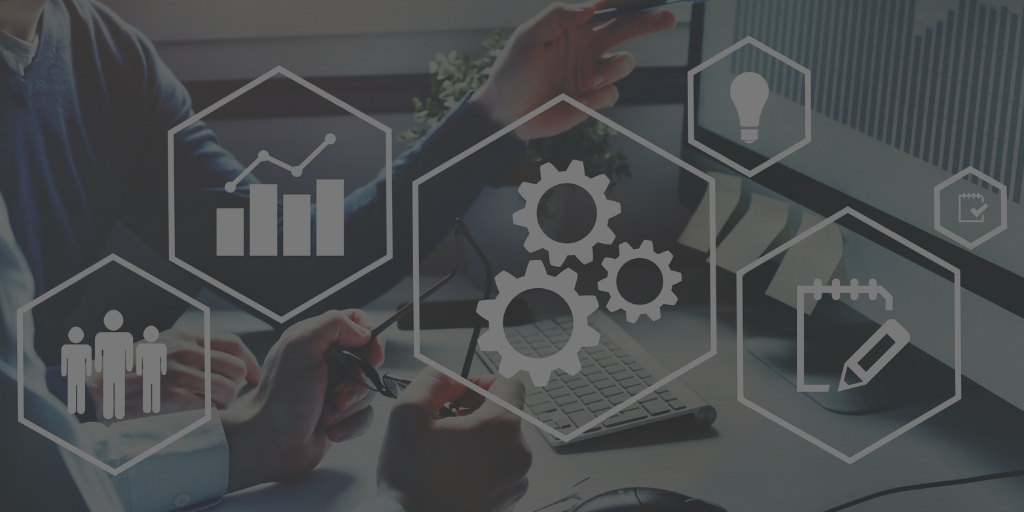
Buyers and sellers may seem like they're from different planets. On one side, buyers have their needs and benefits to consider, while on the other side, sellers have their revenue goals and customer satisfaction to prioritise.
It's like buyers are on an unpredictable journey, while sellers are following a well-defined process. However, the truth is that successful sales and marketing teams find a way to navigate both paths and achieve their desired outcomes.
Gartner research finds that "when B2B buyers are considering a purchase‚ they spend only 17% of that time meeting with potential suppliers. When buyers are comparing multiple suppliers‚ the amount of time spent with any one sales rep may be only 5% or 6%."
This shift in the buyer's journey means a different approach is required for salespeople who want to influence, engage, and educate buyers earlier in the journey.
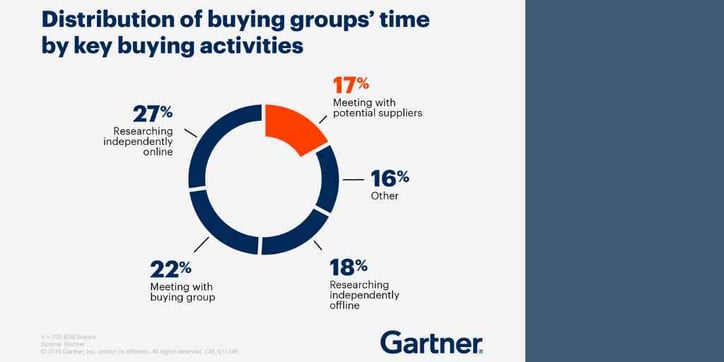
We've all heard countless tales about how the buyer's journey is changing - how it's becoming more like a wild rollercoaster ride, with buyers taking control like never before. And it's true, to a certain extent.
But what's not true, despite what many people believe, is that the journey has now become a random walk, with buyers leaping from one stage to another with no rhyme or reason. The truth is, savvy sellers know better.
Today, we'll reveal how these top performers stay ahead of the game and how sales enablement plays a crucial role in establishing strong connections between the sales process and the buyer's journey.
No doubt, the modern buyer is much better informed. With easier access to information, they can do much more research online, but they still have barriers to overcome -
As hard as it has become to sell in today’s world, it has become that much more difficult to buy. The single biggest challenge of selling today is not selling, it is actually our customers’ struggle to buy. Brent Adamson | Distinguished VP, Advisory | Gartner
How much friction is there in your buyer's journey? Could it be improved? Before we dive into the nitty-gritty of aligning your buyer's journey with the sales process, let's take a quick trip down memory lane.
 Like the classic stages of the buyer's journey, the fundamentals of sales and marketing have remained unchanged. The decision-making process, especially for complex purchases, still follows the same tried-and-true pattern that has been around for decades.
Like the classic stages of the buyer's journey, the fundamentals of sales and marketing have remained unchanged. The decision-making process, especially for complex purchases, still follows the same tried-and-true pattern that has been around for decades.
Whether buying a fancy new car, a top-of-the-range watch that's a tad out of your budget, or cutting-edge enterprise software, the journey remains consistent.
While some stages may occasionally be breezed through (perhaps you're already well aware of the existence of designer watches) and there may be some circularity (for instance, reaching the negotiation phase only to stumble upon a new solution and restart the whole process), the buyer's journey of the future will still be recognisable.
However, how sales teams adapt and make the most of it will change.
When we compare the classic sales process to the buyer's journey, it's really clear that many of today's sales teams are struggling to align the two.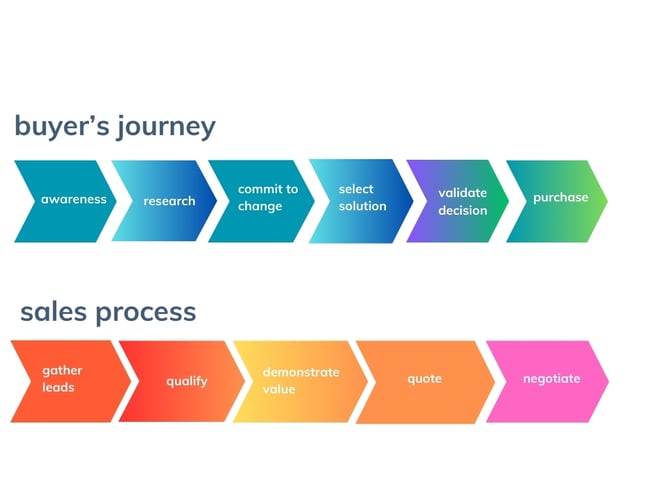
So, the burning question for sales and marketing teams is: How can I tweak my sales process to fit seamlessly into the buyer's journey?
Revising the B2B sales process is a game-changer for sales managers who want to boost their reps' effectiveness and ensure consistency in leveraging sales content for maximum impact.
The main reason is that it forces businesses to truly understand the needs of their target audience. Instead of focusing solely on a scripted sequence of product—or service-first messages, aligned businesses prioritise guiding buyers through their journey.
They tailor their process to match buyers' needs while still being flexible enough to challenge, support, and advise them at every stage.
By investing the necessary upfront time in executing this strategy, aligned businesses position themselves for significantly improved sales effectiveness.
Take a look at the example below illustrating an aligned sales process mapped against the buyer's journey. This process is certainly more customer-centric.

Sellers and buyers operate on distinct paths. While a sales professional guides a lead through the stages of the sales process, prospects and customers follow their own route: the buyer’s journey.
This journey is the path a potential customer takes when they become aware of, evaluate, and decide to purchase a product or service. It mirrors the sales funnel but from the buyer's perspective.
Mapping out your buyer’s journey is crucial as it provides insights into your customers and their decision-making process. This knowledge can be leveraged to enhance your win rate by tailoring the experience, understanding buying motivations, and identifying and addressing objections.
Knowing where a prospect is in the buying process helps sales professionals ask the right questions, understand customer problems, and move the prospect to the next step of the journey in the sales cycle.
Understanding your buyer's journey and alignment with your sales process can enhance sales performance.
When your sellers grasp which stage of the process aligns with each step of the journey, they can:
- Enhance the Customer Experience
- Add value to your product or service
- Accelerate the movement of prospects through the sales funnel
- Boost win rates
Implementing a consistent, buyer-centric sales process enables your sales team to swiftly pinpoint a prospect's position in the buyer’s journey and engage them at the appropriate stage of the sales process.
Begin by creating a table that illustrates the buyer's journey on the top row. Then, skip three rows and add your sales process. In the second row, outline what the buyer hopes to achieve at each stage of the sales process. In the third row, jot down your own objectives for each stage. This will provide you with a comprehensive overview of your sales process and your audience's journey. Take a moment to assess if they align. If they do, fantastic! If not, read on for the solution.
For many sales teams, reframing stage definitions and goals can swiftly resolve any misalignment. For example, a common stage in the sales process is to "qualify" potential buyers by determining their likelihood of making a purchase within a reasonable timeframe. However, from the buyer's perspective, their objective is often "committing to internal change."
By reframing your stages and goals, you can bridge the gap between seller and buyer perspectives, leading to more impactful conversations. To facilitate this process, keep the following questions in mind:
Answering these questions will enable you to establish a content and engagement strategy that aligns with your buyers' demands. To support your sales process from start to finish, consider utilising a sales enablement platform that not only offers the expected content capabilities but also provides customer engagement and analytics.
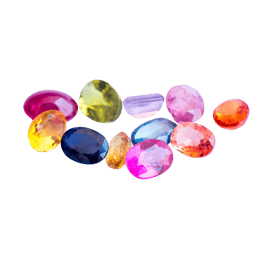 2: Spotting the Gems
2: Spotting the GemsOnce you've aligned your process steps, it's time to uncover those hidden gems of value for your buyers at each stage. Forget about just focusing on product features and capabilities – it's all about evaluating the perfect solution and addressing the different perspectives within your buyer's organisation. So shift your mindset from "What can I get from the buyer?" to "How can I help the buyer get what they truly need?" This simple shift is the key to unlocking better sales performance.
Help buyers round up the essential resources they need to achieve their goals. One way to become their go-to source is by delving into the following categories:
Product and solution education: What product specifications, solution guides, industry-specific materials, or advice from industry experts do your buyers need? Where in the buyer's journey will this information be most beneficial?
Embracing change: What analyst reports, case studies, or ROI calculators can demonstrate the necessity for a change in direction?
Solution selection: How can you utilise evaluation checklists, comparison charts, third-party advice, and product trials to assist buyers in choosing from various options? Does your sales process address this need at the most opportune stage of the buyer's journey?
Validation of selection: Alleviate your buyers' concerns by referencing proof-of-value trials, customer testimonials, and insights from industry experts.
Once you've gained clarity on the above, ensure that your reps can easily locate, share, customise, and analyse the content that fulfils these crucial buyer requirements.
Sales process changes are critical, so it's important to follow the old saying, "Measure twice, cut once." We suggest identifying a handful of superstar sales reps who already have a knack for putting the customer first. The reason? They'll likely have immediate, market-validated feedback and recommendations on whether or not sales process revisions line up with the buyer's journey. (Note: Many of these reps are probably already involved in your sales enablement strategy.)
To really gauge the effectiveness of your new process, consider running a pilot program. Train a subgroup of your sales team on the benefits of aligning your sales process with the buyer's journey, and show them how to put guidance into action. If your sales cycle is long or complex, it might be tough to get statistically significant results from a small sample size. But trust your salespeople's gut feelings in the meantime – they'll quickly let you know if it's working or not, and their insights will be valuable until you can gather more data.
Now comes the fun part - codifying, training, and committing to your new and improved sales process and creating the new playbook. We all know that change is never easy, but by investing in training, you'll give your reps the tools they need to fully grasp the power of your revamped process and how it can make a positive impact on their performance.
But that's not all! If you haven't done so already, it's time to bring your playbook into the digital age. By delivering your playbook in a user-friendly, bite-sized format, you'll give your reps the head start they need to hit the ground running. Trust us, this is hands down one of the best ways we've seen to streamline your sales process and propel your organisation forward at lightning speed. Sales Hub Pro includes five customisable Playbooks as a standard feature.
The better you align perspectives on the buyer's journey and sales process and use them to fine-tune your sales content strategy, the more effective your reps will become.
Obviously, you'll need to adjust your content for context while staying on brand and on message. Smart tools like Content Hub and Canva make it quick and easy to curate content that resonates with your buyer.
So, with your newfound superpowers, drive your business forward and nail those sales targets this year!
FAQs
The buyer's journey is the process customers go through when deciding to purchase a product or service. Understanding this process helps sales teams tailor their approach to meet buyers' needs at each stage.
The buyer's journey typically consists of three stages: awareness, consideration and decision.
Identifying these stages involves understanding your customers' pain points, the challenges they are looking to solve and the information they typically seek at each point.
Strategies include creating targeted content for each stage, training sales teams on buyer personas, and using CRM tools to track customer interactions and preferences.
You can measure effectiveness through metrics like conversion rates, sales cycle length, and customer feedback. Analysing these metrics helps refine your approach.
Common mistakes include failing to understand buyer personas, not providing relevant content, and neglecting to adapt the sales approach as buyers progress through their journey.
Yes, that's a great option. External consultants can help you align your sales process with your buyers journey and help with streamlining and automating elements of your processes as well.
Get in touch to find out how our B2B Sales experts can help you align your sales process with your buyer's journey with a free 30 min consultation.
Align ABM with Account Based Selling for greater success
When your pipeline's a lemon, make lemonade
Comprehensive Guide to B2B Sales
Transform your business with cutting edge eCommerce solutions
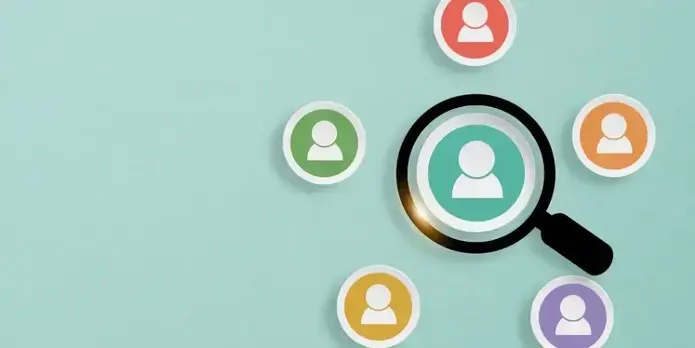
Discover the purpose of buyer's personas: Why they are important for your business and checkout our examples Along with a step-by-step guide on how...

Ideal Customer Profile (ICP) and Buyer Personas are terms often used interchangeably, but they are not the same. They are interconnected, so it's...

Aligning your sales pipeline with a sales view of your buyer's journey is a smart move. Seriously, it's a no-brainer. Especially for B2B Sales...